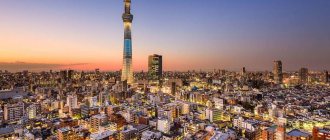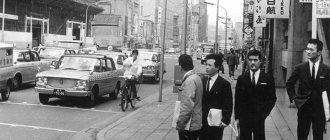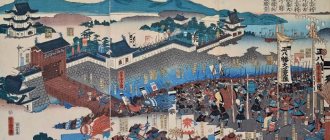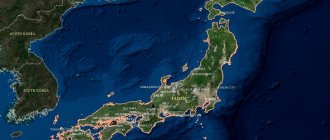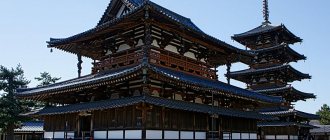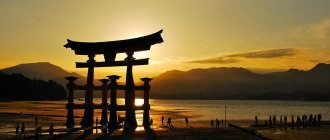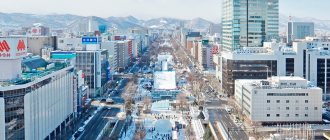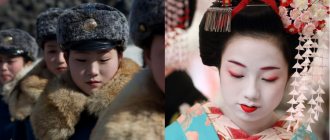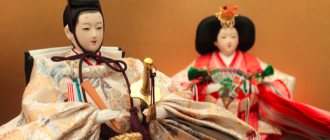Industries of Japan
JAPAN
Geographical, economic and geographical location
Japan is an island nation located on the Japanese archipelago in the Pacific Ocean, which includes more than 6,500 islands. The largest islands are Honshu, Hokkaido, Kyushu and Shikoku. The shores of the archipelago are heavily indented and form many bays and bays.
The seas and oceans surrounding Japan are of exceptional importance for the country as a source of biological, mineral and energy resources. Territory area – 388 thousand square meters. km, population – 126 million people. (10th place in the world), capital – Tokyo.
The economic and geographical position of Japan is determined, first of all, by the fact that it is located in the center of the Asia-Pacific region, which contributes to the country's active participation in the international geographical division of labor.
The geological basis of the archipelago is underwater mountain ranges. About 80% of the territory is occupied by mountains and hills with highly dissected relief with an average height of 1600 - 1700 m. There are about 200 volcanoes, 90 active, including the highest peak - Mount Fuji (3776 m). Frequent earthquakes and tsunamis also have a significant impact on Japan's economy.
The country is poor in mineral resources, but coal, lead and zinc ores, oil, sulfur, and limestone are mined. The resources of its own deposits are small, so Japan is the largest importer of raw materials.
Population
Japan is one of the top ten countries in the world in terms of population. Japan became the first Asian country to move from the second to the first type of population reproduction. Now the birth rate is 12%, the death rate is 8%. Life expectancy in the country is the highest in the world (76 years for men and 82 years for women).
The population is nationally homogeneous, about 99% are Japanese. Of other nationalities, the Koreans and Chinese are significant in number. The most common religions are Shintoism and Buddhism. The population is distributed unevenly across the area. Average density – 340 people per sq. km, but the coastal areas of the Pacific Ocean are among the most densely populated in the world.
More than 85% of the country's inhabitants live in cities. 11 cities have millionaires.
The largest urban agglomerations are Tokyo, Nagoya, Osaka. The agglomerations merge into the Tokyo megalopolis (Takaido) with a population of more than 65 million people.
General characteristics of the farm
The growth rate of the Japanese economy was one of the highest in the second half of the 20th century. The country has largely undergone a qualitative restructuring of the economy. Japan is at a post-industrial stage of development, which is characterized by highly developed industry, but the most growing area is the non-manufacturing sector (services, finance, R&D).
Although Japan is poor in natural resources and imports raw materials for most industries, it ranks 1st or 2nd in the world in the output of many industries. Industry is mainly concentrated within the Pacific Industrial Belt.
Industries of Japan
Electric power industry. Mainly uses imported raw materials. In the structure of the raw material base, oil leads, the share of natural gas, hydropower and nuclear energy is growing, and the share of coal is decreasing.
In the electric power industry, 60% of the power comes from thermal power plants and 28% from nuclear power plants, including Fukushima - the most powerful in the world.
Hydroelectric power stations are located in cascades on mountain rivers. Japan is one of the top ten countries in terms of hydroelectric power generation. In resource-poor Japan, alternative energy sources are being actively developed.
Ferrous metallurgy. The country ranks second in the world in terms of steel production. Japan's share in the global iron and steel market is 23%.
The largest centers, now operating almost entirely on imported raw materials and fuel, are located near Osaka, Tokyo, and Fuji.
Non-ferrous metallurgy. Due to the harmful impact on the environment, primary smelting of non-ferrous metals is being reduced. Conversion plants are located in all major industrial centers.
Mechanical engineering. Provides 40% of industrial production. The main sub-sectors among the many developed in Japan are electronics and electrical engineering, radio industry and transport engineering.
Japan firmly occupies a leading position in the world in shipbuilding, specializing in the construction of large-tonnage tankers and dry cargo ships. The main centers of shipbuilding and ship repair are located in the largest ports (Yokohama, Nagasaki, Kobe). In terms of car production (8.5 million units per year), Japan also ranks second in the world. The main centers are Toyota, Yokohama, Hiroshima.
The main general engineering enterprises are located within the Pacific industrial belt - complex machine tool building and industrial robots in the Tokyo region, metal-intensive equipment in the Osaka region, machine tool manufacturing in the Nagai region.
Population
In terms of population, the Land of the Rising Sun is in the top ten in the world. The Japanese boast the world's longest life expectancy (76 years for men and 82 for women).
The national composition is characterized by relative homogeneity. The Japanese form almost ninety-nine percent of the country's total population. Among other peoples living in Japan there are quite a lot of Koreans, as well as Chinese. The vast majority profess Shintoism or Buddhism. The most densely populated are the shores of the Pacific Ocean. Almost eighty percent of the Japanese live in large cities, eleven of which are cities with over a million people.
Agriculture and Industry of Japan
Japanese agriculture is diversified. In the Land of the Rising Sun they even cultivate pearls.
The basis of the country's agriculture is agriculture. The Japanese have been growing rice for a very long time and in fairly large quantities, but they also pay attention to other grain crops, as well as legumes and tea.
The most prominent roles are played by horticulture, horticulture, sericulture and livestock farming, as well as pearl fishing, fishing and marine fishing, which are classified as agriculture in Japan.
The country's cultivated area is 5.4 million hectares, and the sown area exceeds it due to the fact that in a number of areas 2-3 crops are harvested per year.
More than half of the total area is allocated for grain crops, about 25% for vegetables, the rest of the land is occupied by forage grasses, industrial crops and mulberry trees. However, the main cultivated crop is still rice.
Rice cultivation is one of the key areas of Japanese agriculture.
Vegetables are grown, as a rule, in the suburbs, in large greenhouses, which allows residents of the country to have them on their table all year round.
Sugar beets are cultivated in Hokkaido, and sugar cane in the south.
The country's cattle population reaches 5 million heads (half of them are dairy cows). Pig farming is developing in the southern regions (about 7 million heads).
The center of livestock farming is the north of the country - the island of Hokkaido, where special farms and cooperatives have been created. Most of the feed has to be purchased from other countries. Especially a lot of corn is imported.
At the moment, huge companies are engaged in growing and catching fish.
Seaweed and shellfish are also harvested. Japan's fishing fleet numbers several hundred thousand vessels, but mostly they are all very small.
For locals, fish comes second after rice. These two products have always been part of the daily diet of the average Japanese. Which, in turn, contributed to the development of fishing.
Source
Animals of Japan. Description, names and characteristics of animals in Japan
The fauna of Japan is determined by endemics, that is, individual subspecies of fauna that live only on the island. Very often, animals have small forms compared to mainland representatives. They are called Japanese subspecies; the island has several climatic zones, so the fauna is diverse.
The nearby islands readily welcome migratory birds. There are very few reptiles in Japan, only a few species of lizards and two species of poisonous snakes.
The peculiarity of the animal world of Japan is its wide variety of fauna. Specimens in the wild remained in nature reserves, closed national and marine parks.
In the land of the rising sun there is a special attitude towards animals. Many provinces in Japan have their own sacred animal . For example, in the former capital of Nara it is the sika deer. In marine regions, petrels or three-toed woodpeckers. The green pheasant called “Kiji” is considered to be a national treasure.
Pictured is a raccoon dog
It is typical for Japan to name animals from their place of residence. Numerous islets boast an abundance of subspecies. Northern Kyushu is proud of the white-breasted bear, Japanese macaque, badger, Japanese sable, raccoon dog, moles, mandarin ducks, and pheasants.
*Sika deer is an important and beloved animal by the Japanese. It is he who occupies a special place in fiction and folklore. The body length reaches from 1.6 to 1.8 m, the height at the withers is 90-110 cm.
It has an unusual fiery red color with small white spots. In winter, the color takes on a uniform shade. Inhabits deciduous forests of coastal zones. The horns have four ends, shedding occurs in April, after a month the young shoots are clearly visible. Natural enemies are wolves, leopards, and less commonly foxes.
Dappled deer
*Green pheasant "Kiji" is an animal considered a symbol of Japan . Lives in hilly and bushy areas. Distributed on the islands of Honshu, Shikoku and Kyushu.
The pheasant is an exclusively endemic species, therefore there is a possibility of assigning it a separate species. The bird is painted bright green. The length of the animal ranges from 75-90 cm, where half the length is the tail. Body weight barely reaches 1 kilogram. The female is much smaller than the male, her color looks poor in comparison.
In the photo there is a green pheasant "Kidzi"
*The Japanese macaque is an unusual species of macaque that lives in the northernmost regions of the planet (Honshu Island). They inhabit mainly deciduous and mountain subtropical forests. They feed on plant foods and sometimes do not disdain small insects and crustaceans.
Japanese macaque
*Japanese serow is a representative of the artiodactyls, subfamily Goat. An endemic animal found only in the forests of the island. Honshu, looks like a goat. It reaches one meter in length, height at the withers is 60-90 cm.
It has thick fur, the color can be black, black and white and chocolate. It feeds exclusively on the leaves of thuja and Japanese cypress, and less often on acorns. Leads a diurnal lifestyle, stays alone, gathers in pairs only to reproduce, life expectancy is no more than 5 years.
Pictured is a Japanese serow
*Japanese sable is a member of the mustelid family and is a carnivorous mammal. It is considered a valuable animal living in Japan due to its thick, silky fur.
The specimen has an elongated body (47-50 cm), short legs and a fluffy tail. The color can range from bright yellow to chocolate. The length of the tail is 17-25 cm. Habitat: the southern island regions of Japan, forested and thinned areas.
They feed on insects and mammals, and do not disdain acorns, nuts and berries. Due to the fact that the sable becomes a valuable trophy, its habitat is under state protection. Security or conservation zones have been organized at the distribution sites.
Animal Japanese sable
*Japanese flying squirrel belongs to the squirrel family. An endemic representative inhabiting exclusively mountain evergreen forests of the islands of Honshu and Kyushu. The rodent's body dimensions are 15-20 cm, its weight reaches no more than 200 g.
The body is covered with thick, silky hair with a brown, white or silver tint. It is nocturnal, feeds on nuts, seeds, dry flower buds, and less often insects.
Japanese flying squirrel
*The Japanese hare is a species of the hare family. An animal that lives only in Japan and nearby islands. We can say about it that it is a hare only in miniature, reaching a weight of up to 2.5 kg. The coat color can be all shades of brown.
Sometimes white spots appear on the head and paws. Inhabits meadow areas, open loess areas, clearings and mountain uplands. The animal is a herbivore; in summer it feeds on lush greenery, in winter it eats tree bark and preserved leaves. Only individuals living in the northern regions molt and “change clothes”.
Japanese hare
*The Japanese dormouse is another endemic rodent species characteristic of Japan. It lives in dense and sparse forests throughout the state. Dormouse got its name because of its ability to run quickly along branches while keeping its head down.
It seems that the animal is sleeping on the move. They feed mainly on plant pollen and nectar. Females may eat insects during pregnancy.
Pictured is a Japanese dormouse
*The white-breasted (Himalayan) bear is a predatory mammal, reaching a length of 150-190 cm, height at the withers no more than 80 cm. It has a compact build compared to a brown bear. The muzzle is elongated, the ears are large and rounded.
Agriculture
The basis of Japanese agriculture is farming. The Japanese have been growing rice in large quantities for a very long time, but they also pay attention to other grain crops, as well as legumes and tea.
The cultivated area of the country is 5.4 million hectares, and the sown area exceeds it due to the fact that in a number of areas 2-3 crops are harvested per year.
More than half of the total area is allocated for grain crops, about 25% for vegetables, the rest of the land is occupied by forage grasses, industrial crops and mulberry trees. However, the main cultivated crop is still rice. Rice cultivation is one of the key areas of Japanese agriculture.
Food industry
The leading food industry in Japan is rice farming. About half of all cultivated areas are devoted to rice. In the mid-twentieth century, there was a significant jump in demand for it, while the process of its cultivation was improved for a long time - a crop rotation system was introduced, rice cultivation techniques were refined, allowing large harvests to be obtained from small sown areas. At the beginning of the 21st century, income from rice farming accounts for about 20% of Japan's gross agricultural output. In 2021, grain exports brought in 684 billion yen.
Agriculture
Agriculture is practically the most problematic sector of the Japanese economy. Its share is about 1% of the country's GDP. The reason for the low indicators lies in the small amount of acreage, a reduction in the population engaged in agriculture to 2%, as well as in the dramatically changed diet of Japanese residents - every year they consume more meat and less rice and vegetables. However, the agricultural sector is characterized by high labor and land productivity, good crop yields and animal productivity. About 70% of production comes from crop production - in some areas of the country it is possible to obtain crops 2-3 times a year. The lands allocated for pastures account for about 1.6% of the total area - the largest farms are engaged in livestock farming.
Fishing in the country
Fishing is an important traditional industry in Japan, ranking among the top fish catchers in the world. There are more than 3,000 specialized ports in the country for this type of activity. The coastal seas are famous for their rich and diverse fauna - there are more than 40 species of mackerel alone. Flounder and greenling are also common. Due to the fact that not only fish, but also seaweed is important in the gastronomic preferences of the Japanese, marine culture is well developed here.
10% of national agricultural products are grown on the island of Hokkaido
US$4.17 billion Pork import value in 2021
US$3.07 billion Corn import value in 2021
US$2.82 billion Import value of fish fillets in 2021
US$2.42 billion Import value of crustaceans in 2021
13% of Japan's territory is arable land
$1.66 billion Beef import value in 2021
US$1.53 billionValue of soybean meal imports in 2016
1% share of agriculture in Japan's GDP
US$1.42 billion Coffee import value in 2021
US$1.36 billionWheat import value in 2021
US$1.35 billion Shellfish import value in 2021
US$1.17 billion Poultry meat import value in 2021
USD 1.04 billion Value of rapeseed imports in 2021
90% of the production of grains, vegetables, fruits and nuts, meat, and dairy products comes from agricultural cooperatives, which also sell finished productswbb
The foundations of Japanese aesthetics were laid at the beginning of the aristocratic era in Japan in the 8th century AD. At that time, instead of pomp and abundance, simplicity, sophistication and understatement were admired. Noble people had to be able to understand the play on words and decipher the plots in bouquets of flowers, patterns on clothes and the arrangement of fruit on a tray. All this could not but affect the serving of Japanese food. A plate of food is a composition with special symbolism that must be unraveled before eating. Seasons were also important for the Japanese, of which, in the tradition of that time, there were 24. Products that appeared at the beginning of the season were perceived as the most valuable - they were believed to contribute to longevity. The food was laid out on a plate, following special canons: the eater was not supposed to see one component of the dish, no matter from what angle he looked at it. Most of these traditions have been preserved almost exactly to this day.
Livestock
The center of livestock farming is the north of the country - the island of Hokkaido, where special farms and cooperatives have been created.
Rice. 2. Hokkaido Island.
Most of the feed has to be purchased from other countries. Especially a lot of corn is imported. Livestock farming in Japan is not as well developed as agriculture, but in the second half of the 20th century it received an impetus for development. This was caused by the increasing demand for meat and dairy products. If previously the main food products of the Japanese were rice and fish, then gradually the country gradually switched to the Western path of consumption, when the content of grain crops, potatoes and meat products in the human diet increased. Pig farming is developed in the southern regions of the country, and poultry farming plays an important role in the suburbs.
Meat production is 4 million tons per year, and milk production is 8 million tons.
What have we learned?
Japanese agriculture is diversified. Agriculture is developed here, in which the main cultivated crop is rice. In the field of livestock farming, pig farming, cattle breeding and poultry farming are developed. An important part of agriculture is fishing.
Evaluation of the report
Average rating: 4.5. Total ratings received: 23.
New testsBe among the first on the honor board Did you like the article?
Help the project - click on the button and tell your friends:
Didn’t like it? — Write in the comments what is missing.
Fishing
For Japanese residents, fish comes in second place after rice. These two products have always been part of the daily diet of the average Japanese. This fact, in turn, contributed to the development of fishing.
At the moment, large companies are engaged in growing and catching fish. Seaweed, shellfish and pearl fishing are also harvested here. Japan's fishing fleet numbers several hundred thousand vessels, but mostly they are all very small.
Aquaculture has become widespread - artificial breeding of fish in lagoons, mountain lakes and rice fields. In addition, there are farms in Japan that breed pearl mussels.
Rice. 3. Aquaculture in Japan.
Economic development of Japan
In the early 90s, Japan had the most advanced production and technical base. In this position, Japan was inferior to the United States and some developed countries of Western Europe. This circumstance has allowed Japan to significantly develop in the field of new technologies.
Rice. 2. Robotics of Japan.
Thanks to this, Japan is now in third position among the world's trading giants after the USA and Germany
A characteristic feature of the lifestyle of Japanese society is frugality. Whenever possible, the Japanese strive to put aside savings for a rainy day. This feature of millions of Japanese became the main source of financing for the development of the Japanese economy in difficult times.
Rice. 3. Japanese computer.
The relative isolation of the state from the centers of Eastern and Western civilization played an important role in the development of the country's economy. This resulted in the Japanese seeking to borrow aspects of advanced cultures and then assimilate them into their traditional values.
The growth of the Japanese economy was also significantly influenced by the fact that the state, which actually does not have its own raw material base, imports raw materials (especially oil) at a fairly low cost and thanks to this receives cheap energy. The leading position in the development of the economy is also occupied by conducting its own scientific research in various fields, as well as the creation of scientific and production complexes and zones.
Current economic situation in Japan
The Japanese economy developed rapidly after World War II, so in a short period it has come a long way, showing the whole world its achievements in the fields of science, technology, education, industry and trade. After the defeat in the war, the country not only fully recovered, but in terms of achieved economic power it came into second place in the world after the United States. The country has been the second economy in the world since 1968, but in 2010 it lost this position to China. Having become a world creditor, Japan carried out a qualitative restructuring of the entire economic life and created the foundations of a post-industrial society. The Japanese “economic miracle” did not appear out of nowhere.
The country's economy during this period had its own distinctive features:
- There was a merger into closely related groups of manufacturers, resource suppliers, product distributors, and banks. The groups were called keiretsu ;
- There was a mutually beneficial relationship between entrepreneurs and government;
- Large corporations offered lifetime employment guarantees;
- There was an active and active trade union movement in the country.
Finished works on a similar topic
The sharp jump in economic development also had its reasons:
- Cheap labor;
- Trust in the banking system;
- The state had control over foreign trade;
- The products produced were export-oriented;
- State support for national producers;
- American lending;
- Post-war political stability;
- Mastering new technologies.
As a result of all the activities carried out, Japan has achieved high technical excellence, especially in the field of advanced technologies. A major role in the country's economy is played by such areas as banking services, insurance, real estate, transport, retail trade, telecommunications, and construction. Japan ranked $19th in terms of GDP to hours worked back in 2007. Japanese workers today have the world's highest hourly wages and the lowest unemployment rate.
True, it must be said that in 2009, unemployment began to increase and reached $5.1%. There is an index of ease of doing business and according to its indicator in 2009 the country was in $13$ place. Japan ranked nineteenth on the Economic Freedom Index. Among Asian countries it had $5$ place. Japanese capitalism has its own characteristics, for example, keiretsu that emerged in the post-war period and today play a significant role in the country's economy. Lifelong employment in one company is also typical for the country.
History of industrial development in Japan
The well-known “Japanese model” of the economy was formed over 150 years. Back in the second half of the 18th century, the country's government began to rapidly develop industrial production. And the first task was to prevent colonization by Western countries. Development began with agriculture, then factories appeared, which formed into large concerns or “zaibatsu” of Mitsubishi, Sumitomo and Mitsui. Before the outbreak of World War II, Japan developed a powerful heavy industry, which allowed the formation of a middle class. But, despite the growth in industrial production, the country's economy still lagged behind other powers. The main export item was silk, although it accounted for only 13% of the total volume of exported goods. Industries (in particular, mechanical engineering) were still technologically undeveloped at that time. The production of consumer goods has just begun to appear.
Finished works on a similar topic
- Coursework Industry of Japan 470 rub.
- Abstract Industry of Japan 230 rub.
- Test work Industry of Japan 190 rub.
Receive completed work or advice from a specialist on your educational project Find out the cost The “Japanese model” of the economy provided for the presence of two elements:
- lifetime employment of staff;
- dependence of status and remuneration on work experience.
Definition 1
Lifelong hiring of employees is a guaranteed stable job and life, but over time it leads to a decrease in people’s initiative, excessive subordination and a decrease in interest in the development of the enterprise.
After the end of the war, industry and the economy began to recover and develop at a fairly rapid pace. The key goals of Japan's socio-economic development were the reduction or complete elimination of hyperinflation; investing all resources into restoring industrial production.
The government devoted all its efforts to solving the second problem, and by the end of the 20th century the industry had almost completely recovered. This leap contributed to the fact that Japan began to be considered one of the advanced countries on the world stage.
Need advice from a teacher in this subject area? Ask a question to the teacher and get an answer in 15 minutes! Ask a Question
Note 1
Japan is not just the second country in terms of domestic national product (GNP), but also the main competitor of the United States. She is the leader of scientific and technological progress (NTP).
Industry of Japan
The development of Japanese industry followed a mainly evolutionary path. The revolutionary path of development began to dominate after the energy and raw materials crises of the $70s. The country limited the growth of energy-intensive and metal-intensive industries, because they were completely dependent on imported fuel and raw materials, and focused on the latest knowledge-intensive industries. Japan created its basic industries - energy, metallurgy, automotive industry, shipbuilding, chemical industry, petrochemicals, construction industry - practically anew and using imported raw materials, but with the obligatory consideration of the latest achievements of technology and technology. The Japanese purchased a significant part of patents and licenses abroad and, above all, in the USA and Germany, and then adapted them to their conditions.
The development of knowledge-intensive industries has made Japan a leader in the field of electronics, robotics, and biotechnology. The country allocates huge funds for the development of science and ranks first among developed countries in terms of the share of expenditures on it. The number of scientists in Japan is greater than in Great Britain, Germany, and France combined. Modern Japan is one of the world's leading economic powers. Japan ranks first in the world in the output of many basic industries, despite the lack of its own raw materials. Focusing on imported raw materials, Japanese industry is concentrated mainly in the Pacific industrial belt. This is only 13% of the country's territory and $80$% of industrial output.
metallurgy has changed a lot - today there are powerful plants equipped with the latest technology. Ore for metallurgy is supplied by Malaysia and Canada, and coal by the USA and Australia. In the non-ferrous metallurgy, Japan is in second place after the United States in the production of refined copper.
The energy sector is developing entirely on imported raw materials. The country's electric power industry is well developed, with thermal power plants accounting for $60$% of capacity. Nuclear power plants have appeared in the country since the mid-60s, and to date there are more than 20 of them. The raw materials for their work are also imported. Together they provide $30$% of the country's total electricity.
The shipyards of Yokohama, Osaka, Kobe, and Nagasaki launch the world's largest supertankers, large-capacity tankers, and bulk carriers. Shipbuilding remains firmly in first place in the world. The main shipbuilding centers are the largest ports of Yokohama and Nagasaki. The industry structure of mechanical engineering is very complex. In addition to ships of various types, cars, instruments, the country is developing electronics and the radio industry. The largest centers of the industry are Toyota, Yokohama, and Hiroshima. The radio-electronic and electrical engineering industry focuses on centers where there are highly qualified personnel, a developed transport system and a scientific and technical base. The largest Japanese conglomerate by number of employees - $341 thousand people - is the Hitachi Corporation, headquartered in Tokyo, with assets of $81.3 billion and annual sales of $65.1 billion.
Oil refining and chemical industry enterprises gravitate towards the centers of the Pacific industrial belt . The industries use imported raw materials and have a high level of development. In addition to these basic industries, the country is developing the pulp and paper, light, food, and fishing industries.
Metallurgical industry
Industry and agriculture in France
After the Second World War, the industry was in decline, but in the early 50s the government decided to change this fact and outlined priorities. A course was set for the development of various industries, the main feature being the construction of new enterprises using the latest technologies. Thus, it was possible to develop ferrous and non-ferrous metallurgy, due to which Japan today occupies a leading position in world industry. The factories are distinguished by a high level of technical equipment and automation.
Comparative table of products:
| Year | Smelting, million tons |
| 1950 | 5 |
| 1960 | 22 |
| 1970 | 93 |
| 1980 | 111 |
| 1990 | 110 |
| 2000 | 108 |
Along with food, heavy and other industries, there is also a chemical industry. It ranks 1st in Asia and 15th position in the domestic production structure. This includes the following products:
- plastic;
- paint and varnish products;
- medications;
- various organic compounds.
But many people are interested in what industry is practically absent in Japan and why nuclear energy belongs to it.
The shutdown of most nuclear power plants located near large cities occurred due to a strong earthquake and tsunami. The result of a natural disaster was an accident at the Fukushima power plant. The leakage of radioactive elements led to the contamination of 3% of the country's territory. Thus, natural gas came to replace the atom. The mining industry is also poorly developed, mainly due to the small amount of minerals.
Metallurgy
The country has few resources, and therefore a strategy for the development of the metallurgical complex was developed, aimed at energy and resource conservation. Innovative solutions and technologies allowed enterprises to reduce electricity consumption by more than a third, and innovations were applied both at the level of individual companies and throughout the entire industry.
Metallurgy, like other branches of Japanese industry, received active development after the war. However, if other states sought to modernize and update their existing technologies, the government of this country took a different path. The main efforts (and money) were aimed at equipping enterprises with the most advanced technologies at that time.
The industry's rapid development continued for about two decades and peaked in 1973, when Japan alone accounted for 17.27% of the world's steel production. Moreover, from the point of view of quality, it claims to be a leader. This was stimulated, among other things, by the import of metallurgical raw materials. After all, more than 600 million tons of coke and 110 million tons of iron ore products are imported annually.
By the mid-90s, Chinese and Korean metallurgical enterprises competed with the Japanese, and the country began to lose its leadership position. In 2011, the situation worsened due to a natural disaster and the Fukushima-1 disaster, but according to rough estimates, the overall decrease in production rates did not exceed 2%.
Pros and cons of the Japanese economy in brief
The positive aspects include:
- advanced technologies;
- the presence of a safety margin and a high standard of living of people;
- production and sale worldwide of high quality products with high added value.
The disadvantages are:
- large public debt compared to GDP;
- weak consumer demand within the country (supply dominates);
- deflation and excessively high wages;
- lack of own resources that have to be imported;
- age structure of the population.
The country's authorities are trying to reduce the negative impact of negative factors on the Japanese economy, but so far the measures taken have not changed the situation radically, and the public debt is only growing. This is also reflected in Japan's budget.
Aircraft manufacturing[edit | edit code]
Japan's aviation industry began after World War I and initially relied heavily on ideas and developments borrowed from abroad. By the time of World War II, the Japanese aircraft industry had significant potential, which allowed the country in 1942-1945. conduct active combat operations in the air.
After defeat in the war, the country was only allowed in 1952 to restore the production of spare parts and carry out repairs of American aircraft and helicopters that participated in the war in Korea and then in Vietnam.
- Kawasaki
Corporation - military aircraft. - IHI Corporation -
aircraft engines.
see Category:Japanese aircraft manufacturing companies
Post-war Japan
After the end of the war, Japan was faced with a dilemma - to concentrate entirely on overcoming the then hyperinflation or to devote all its efforts to restoring production, which had suffered greatly during the war. The government urgently needed to look for ways to resolve their crisis. The second path was chosen.
Japan adhered to a reform model, the main points of which were the following: providing cheap and targeted loans, state control over foreign economic and foreign exchange activities, pursuing a policy of protecting national capital in the banking and manufacturing sectors, protecting the agricultural sector (allocating subsidies to agricultural workers) and most importantly, was a model of state regulation of the economy was created, which was based on the interaction of the economic system of private entrepreneurship and the administrative apparatus. The results were not long in coming.
In less than ten years, Japanese industrial production was restored by 80%. Japan moved away from the policy of strict financial regulation (the competitiveness of the national currency and industry in the world spoke for itself). After the war, the country was prohibited from having armed forces, which allowed the government to concentrate on the agricultural issue (most of the land was given for ransom to the peasants) and put the main emphasis on the development of science and new technologies. Such a sharp economic leap was called the “Japanese economic miracle.”

